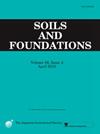天然土壤的抗剪强度预测:以形态数据为中心的方法
IF 3.3
2区 工程技术
Q2 ENGINEERING, GEOLOGICAL
引用次数: 0
摘要
颗粒材料在作用于颗粒的法向力下的变形特征和构成行为取决于颗粒结构的几何形状、织物和颗粒间摩擦。本研究利用深度学习(DL)技术研究了颗粒形态对五种天然砂的摩擦力和膨胀性的影响。使用计算机断层扫描的三维(3D)成像技术来计算收集的天然砂的形态(圆度和球度)。在不同密度和约束应力(σ3)下对五种不同的天然砂进行了三轴测试。从三轴试验结果中得出了峰值摩擦角(φp)、临界状态摩擦角(φcs)和膨胀角(ψ),并使用传统的多元线性回归(MLR)模型和 DL 技术进行了建模。共训练了 100 个第一和第二隐藏层大小不同的深度人工神经网络(DANN)模型。使用 MLR 的结果是,φp、φcs 和 ψ 的 R2 分别为 0.709、0.565 和 0.795,而表现最好的 DANN(第一和第二隐藏层分别为 30 和 50 个神经元)的所有输出(φp、φcs 和 ψ)的总 R2 为 0.956。使用表现最佳的 DANN 模型,利用权重分割技术计算出每个参数在预测 φp、φcs 和 ψ 时的重要性得分。σ3的重要性最高,其次是相对密度、圆度和球度,相对重要性均超过10%。此外,还进行了敏感性分析,以研究各参数对剪切参数的影响,确保所建模型的稳健性。本文章由计算机程序翻译,如有差异,请以英文原文为准。
Natural soils’ shear strength prediction: A morphological data-centric approach
The deformation characteristics and constitutive behavior of granular materials under normal forces acting on particles are dependent on the geometry of the grain structure, fabrics and the inter-particle friction. In this study, the influence of particle morphology on the friction and dilatancy of five natural sands was investigated using deep learning (DL) techniques. A Three-dimensional (3D) imaging technique using computed tomography was utilized to compute the morphology (roundness and sphericity) of collected natural sands. Triaxial tests were conducted on the five different natural sands at different densities and confinement stresses (σ3). From the triaxial results, peak friction angle (, critical state friction angle (), and dilatancy angle (ψ) were obtained and modeled using conventional multiple linear regression (MLR) models and DL techniques. A total of 100 deep artificial neural networks (DANN) models were trained at different sizes of first and second hidden layers. The use of MLR resulted in R2 of 0.709, 0.565, and 0.795 for , and ψ, respectively, while the best performed DANN (30 and 50 neurons for the 1st and 2nd hidden layers, respectively) had R2 of 0.956 for all outputs (, and ψ) combined. Using the best-performed DANN model, the weight partitioning technique was used to compute an importance score for each parameter in predicting , and ψ. The σ3 had the highest importance followed by relative density, roundness, and sphericity with a relative importance of more than 10%. In addition, sensitivity analysis was conducted to investigate the effect of each parameter on the shear parameters and ensure the robustness of the developed model.
求助全文
通过发布文献求助,成功后即可免费获取论文全文。
去求助
来源期刊

Soils and Foundations
工程技术-地球科学综合
CiteScore
6.40
自引率
8.10%
发文量
99
审稿时长
5 months
期刊介绍:
Soils and Foundations is one of the leading journals in the field of soil mechanics and geotechnical engineering. It is the official journal of the Japanese Geotechnical Society (JGS)., The journal publishes a variety of original research paper, technical reports, technical notes, as well as the state-of-the-art reports upon invitation by the Editor, in the fields of soil and rock mechanics, geotechnical engineering, and environmental geotechnics. Since the publication of Volume 1, No.1 issue in June 1960, Soils and Foundations will celebrate the 60th anniversary in the year of 2020.
Soils and Foundations welcomes theoretical as well as practical work associated with the aforementioned field(s). Case studies that describe the original and interdisciplinary work applicable to geotechnical engineering are particularly encouraged. Discussions to each of the published articles are also welcomed in order to provide an avenue in which opinions of peers may be fed back or exchanged. In providing latest expertise on a specific topic, one issue out of six per year on average was allocated to include selected papers from the International Symposia which were held in Japan as well as overseas.
 求助内容:
求助内容: 应助结果提醒方式:
应助结果提醒方式:


